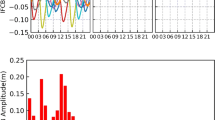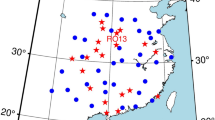Abstract
At present, reliable ambiguity resolution in real-time GPS precise point positioning (PPP) can only be achieved after an initial observation period of a few tens of minutes. In this study, we propose a method where the incoming triple-frequency GPS signals are exploited to enable rapid convergences to ambiguity-fixed solutions in real-time PPP. Specifically, extra-wide-lane ambiguity resolution can be first achieved almost instantaneously with the Melbourne-Wübbena combination observable on L2 and L5. Then the resultant unambiguous extra-wide-lane carrier-phase is combined with the wide-lane carrier-phase on L1 and L2 to form an ionosphere-free observable with a wavelength of about 3.4 m. Although the noise of this observable is around 100 times the raw carrier-phase noise, its wide-lane ambiguity can still be resolved very efficiently, and the resultant ambiguity-fixed observable can assist much better than pseudorange in speeding up succeeding narrow-lane ambiguity resolution. To validate this method, we use an advanced hardware simulator to generate triple-frequency signals and a high-grade receiver to collect 1-Hz data. When the carrier-phase precisions on L1, L2 and L5 are as poor as 1.5, 6.3 and 1.5 mm, respectively, wide-lane ambiguity resolution can still reach a correctness rate of over 99 % within 20 s. As a result, the correctness rate of narrow-lane ambiguity resolution achieves 99 % within 65 s, in contrast to only 64 % within 150 s in dual-frequency PPP. In addition, we also simulate a multipath-contaminated data set and introduce new ambiguities for all satellites every 120 s. We find that when multipath effects are strong, ambiguity-fixed solutions are achieved at 78 % of all epochs in triple-frequency PPP whilst almost no ambiguities are resolved in dual-frequency PPP. Therefore, we demonstrate that triple-frequency PPP has the potential to achieve ambiguity-fixed solutions within a few minutes, or even shorter if raw carrier-phase precisions are around 1 mm. In either case, we conclude that the efficiency of ambiguity resolution in triple-frequency PPP is much higher than that in dual-frequency PPP.



Similar content being viewed by others
References
Bock Y, Melgar D, Crowell BW (2011) Real-time strong-motion broadband displacements from collocated GPS and accelerometers. Bull Seismol Soc Am 101(6):2904–2925
Braasch MS, Van Dierendonck AJ (1999) GPS receiver architectures and measurements. P IEEE 87(1):48–64
Caissy M, Agrotis L, Weber G, Hernández-Pajares M, Hugentobler U (2012) The international GNSS real-time service. GPS World 23(6):52–58
Cocard M, Bourgon S, Kamali O, Collins P (2008) A systematic investigation of optimal carrier-phase combinations for modernized triple-frequency GPS. J Geod 82(9):555–564
Collins P, Bisnath S, Lahaye F, Héroux P (2010) Undifferenced GPS ambiguity resolution using the decoupled clock model and ambiguity datum fixing. J Inst Navigat 57(2):123–135
Dong D, Bock Y (1989) Global positioning system network analysis with phase ambiguity resolution applied to crustal deformation studies in California. J Geophys Res 94(B4):3949–3966
Dow JM, Neilan RE, Rizos C (2009) The international GNSS service in a changing landscape of global navigation satellite systems. J Geod 83(3–4):191–198
Feng Y (2008) GNSS three carrier ambiguity resolution using ionosphere-reduced virtual signals. J Geod 82(12):847–862
Feng Y, Li B (2010) Wide area real time kinematic decimetre positioning with multiple carrier GNSS signals. Sci China Ser D 53(5):731–740
Ge M, Gendt G, Rothacher M, Shi C, Liu J (2008) Resolution of GPS carrier-phase ambiguities in precise point positioning (PPP) with daily observations. J Geod 82(7):389–399
Geng J, Meng X, Dodson AH, Ge M, Teferle FN (2010a) Rapid re-convergences to ambiguity-fixed solutions in precise point positioning. J Geod 84(12):705–714
Geng J, Meng X, Dodson AH, Teferle FN (2010b) Integer ambiguity resolution in precise point positioning: method comparison. J Geod 84(9):569–581
Geng J, Teferle FN, Meng X, Dodson AH (2011) Towards PPP-RTK: ambiguity resolution in real-time precise point positioning. Adv Space Res 47(10):1664–1673
Geng J, Shi C, Ge M, Dodson AH, Lou Y, Zhao Q, Liu J (2012) Improving the estimation of fractional-cycle biases for ambiguity resolution in precise point positioning. J Geod 86(8):579–589
Griffiths J, Ray JR (2009) On the precision and accuracy of IGS orbits. J Geod 83(3–4):277–287
Hammond WC, Brooks BA, Bürgmann R, Heaton T, Jackson M, Lowry AR, Anandakrishnan S (2011) Scientific value of real-time global positioning system data. Eos Trans 92(15):125
Henkel P, Günther C (2008) Precise point positioning with multiple Galileo frequencies. In: Proceedings of the IEEE/ION symposium on position, location and navigation, Monterey, CA, pp 592–599
Henkel P, Günther C (2012) Reliable integer ambiguity resolution: multi-frequency code carrier linear combinations and statistical a priori knowledge of attitude. J Inst Navigat 59(1):61–75
Ji S, Chen W, Zhao C, Ding X, Chen Y (2007) Single epoch ambiguity resolution for Galileo with the CAR and LAMBDA methods. GPS solut 11(4):259–268
Jung J, Enge P, Pervan B (2000) Optimization of cascade integer resolution with three civil GPS frequencies. In: Proceedings of ION GPS 13th international technical meeting of the satellite division, Salt Lake City, UT, pp 2191–2200
Klobuchar JA (1987) Ionospheric time-delay algorithm for single-frequency GPS users. IEEE T Aero Elec Sys AES 23(3):325–331
Laurichesse D, Mercier F, Berthias JP, Broca P, Cerri L (2009) Integer ambiguity resolution on undifferenced GPS phase measurements and its application to PPP and satellite precise orbit determination. J Inst Navigat 56(2):135–149
Li B, Feng Y, Shen Y (2010) Three carrier ambiguity resolution: distance-independent performance demonstrated using semi-generated triple frequency GPS signals. GPS Solut 14(2):177–184
Li X, Zhang X, Ge M (2011) Regional reference network augmented precise point positioning for instantaneous ambiguity resolution. J Geod 85(3):151–158
Loyer S, Perosanz F, Mercier F, Capdeville H, Marty JC (2012) Zero-difference GPS ambiguity resolution at CNES-CLS IGS analysis center. J Geod 86(11):991–1003
Melbourne WG (1985) The case for ranging in GPS-based geodetic systems. In: Proceedings of 1st international symposium on precise positioning with the global positioning system, Rockville, MD, pp 373–386
Niell AE (1996) Global mapping functions for the atmosphere delay at radio wavelengths. J Geophys Res 101(B2):3227–3246
Odijk D, Teunissen PJG (2008) ADOP in closed form for a hierarchy of multi-frequency single-baseline GNSS models. J Geod 82(8):473–492
Odijk D, Teunissen PJG, Zhang B (2012) Single-frequency integer ambiguity resolution enabled GPS precise point positioning. J Surv Eng-ASCE 138(4):193–202
Ray JK (2000) Mitigation of GPS code and carrier phase multipath effects using a multi-antenna system. PhD thesis, University of Calgary, Alberta, Canada
Richert T, El-Sheimy N (2007) Optimal linear combinations of triple frequency carrier phase data from future global navigation satellite systems. GPS Solut 11(1):11–19
RTCA (2006) Minimum operational performance standards for global positioning system/wide area augmentation system airborne equipment. Doc DO-229D, Washington, DC, 13 Dec 2006
Saastamoinen J (1973) Contribution to the theory of atmospheric refraction: refraction corrections in satellite geodesy. Bull Geod 107(1):13–34
Teunissen PJG (1995) The least-squares ambiguity decorrelation adjustment: a method for fast GPS integer ambiguity estimation. J Geod 70(1–2):65–82
Teunissen PJG (1997a) A canonical theory for short GPS baselines. Part IV: precision versus reliability. J Geod 71(9):513–525
Teunissen PJG (1997b) On the GPS widelane and its decorrelating property. J Geod 71(9):577–587
Teunissen PJG (1997c) On the sensitivity of the location, size and shape of the GPS ambiguity search space to certain changes in the stochastic model. J Geod 71(9):541–551
Teunissen PJG (2000) The success rate and precision of GPS ambiguities. J Geod 74(3–4):321–326
Teunissen PJG, de Jonge PJ, Tiberius CCJM (1997) The least-squares ambiguity decorrelation adjustment: its performance on short GPS baselines and short observation spans. J Geod 71(10):589–602
Teunissen PJG, Joosten P, Tiberius C (2002) A comparison of TCAR, CIR and LAMBDA GNSS ambiguity resolution. In: Proceedings of ION GPS 15th international technical meeting of the satellite division, Portland, OR, pp 2799–2808
Van Dierendonck AJ, Fenton P, Ford T (1992) Theory and performance of narrow correlator spacing in a GPS receiver. J Inst Navigat 39(3):265–283
Vollath U, Birnbach S, Landau H, Fraile-Ordońez JM, Martín-Neira M (1999) Analysis of three-carrier ambiguity resolution technique for precise relative positioning in GNSS-2. J Inst Navigat 46(1):13–23
Ward PW, Betz JW, Hegarty CJ (2006) Understanding GPS: principles and applications. In: Kaplan E, Hegarty C (eds) Satellite signal acquisition, tracking, and data demodulation, 2nd edn. Artech House Inc., Norwood, pp 153–241
Werner W, Winkel J (2003) TCAR and MCAR options with Galileo and GPS. In: Proceedings of ION GPS/GNSS 16th international technical meeting of the satellite division, Portland, OR, pp 790–800
Wübbena G (1985) Software developments for geodetic positioning with GPS using TI-4100 code and carrier measurements. In: Proceedings of 1st international symposium on precise positioning with the global positioning system, Rockville, MD, pp 403–412
Zhang B, Teunissen PJG, Odijk D (2011) A novel un-differenced PPP-RTK concept. J Navig 64(S1):S180–S191
Zumberge JF, Heflin MB, Jefferson DC, Watkins MM, Webb FH (1997) Precise point positioning for the efficient and robust analysis of GPS data from large networks. J Geophys Res 102(B3):5005–5017
Acknowledgments
This study is supported by a Green Scholar fellowship awarded to the first author by the Cecil H. and Ida M. Green Foundation for Earth Sciences and an NASA Grant (No. NNX12AK24G). We are very grateful to Nottingham Geospatial Institute in the UK for their simulated triple-frequency GPS data. Special thanks go to Mr. Marcus Andreotti, Ms. Sreeja Vadakke Veettil and the Spirent support team who patiently taught the first author to understand and operate GSS8000. The authors thank Dr. Willis and three anonymous reviewers for their constructive comments which have improved the paper significantly.
Author information
Authors and Affiliations
Corresponding author
Appendix: Tracking loop measurement errors
Appendix: Tracking loop measurement errors
The dominant sources for the phase error that originates in a GPS receiver phase-locked loop (PLL) include its thermal noise, oscillator noise and dynamic stress error (Ward et al. 2006). Normally, the PLL thermal noise is taken as the only source of the carrier tracking error, because the oscillator noise can be either transient or negligible, and the dynamic stress error can be ignored for a stationary receiver. In particular, the thermal noise in the unit of length for an arctangent PLL can be approximated as
where \(\lambda \) is the carrier-phase wavelength; \(W_\mathrm{n}\) is the carrier loop noise bandwidth in Hz; \(C/N_0\) is the carrier-to-noise ratio expressed as a ratio in Hz, and \(10\log C/N_0=(C/N_0)_\mathrm{dB}\) which is expressed in dB-Hz; and \(T_\mathrm{i}\) is the predetection integration time in seconds. In this study, Eq. (12) is used to quantitatively assess the nominal precision of the simulated carrier-phase measurements. For the Septentrio PolaRxS Pro receiver in this study, \(W_\mathrm{n}\) is 15 Hz and \(T_\mathrm{i}\) is 10 ms. \((C/N_0)_\mathrm{dB}\) is derived for each frequency as the mean of the signal strength measurements given by the receiver.
In addition, if there are no multipath or interference effects, the dominant sources of the pseudorange error in a GPS receiver delay-locked loop (DLL) include its thermal noise and dynamic stress error (Braasch and Van Dierendonck 1999). To quantify the precision of the simulated pseudorange measurements, we have to know the early-to-late correlator spacing (ELP) besides \(W_\mathrm{n}\), \(T_\mathrm{i}\) and \(C/N_0\) (Van Dierendonck et al. 1992; Ward et al. 2006). Unfortunately, ELP is kept by Septentrio as proprietary information and we cannot access this quantity. In this case, we tried various possible values for ELP, but found that the calculated nominal precision for the simulated pseudorange measurements is too high, in contrast to the nominal precision of carrier-phase measurements. Finally, we conservatively presume 3 m for the pseudorange precision throughout this study.
Rights and permissions
About this article
Cite this article
Geng, J., Bock, Y. Triple-frequency GPS precise point positioning with rapid ambiguity resolution. J Geod 87, 449–460 (2013). https://doi.org/10.1007/s00190-013-0619-2
Received:
Accepted:
Published:
Issue Date:
DOI: https://doi.org/10.1007/s00190-013-0619-2




